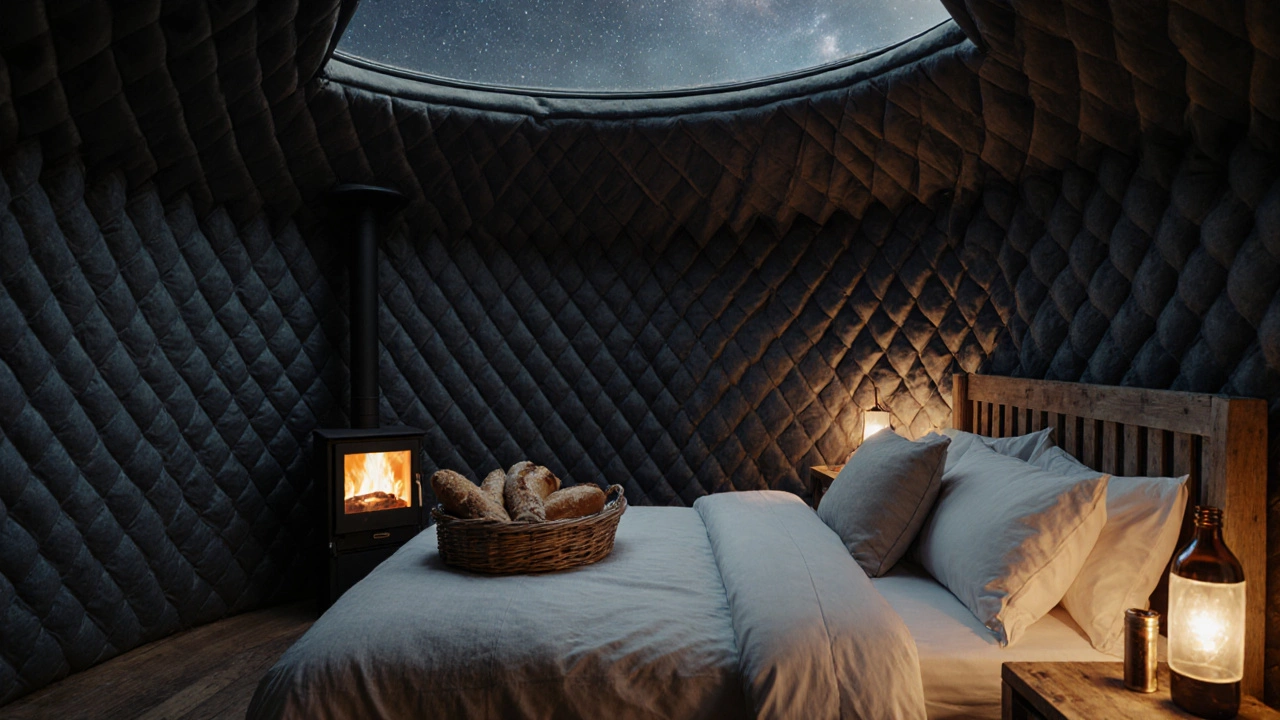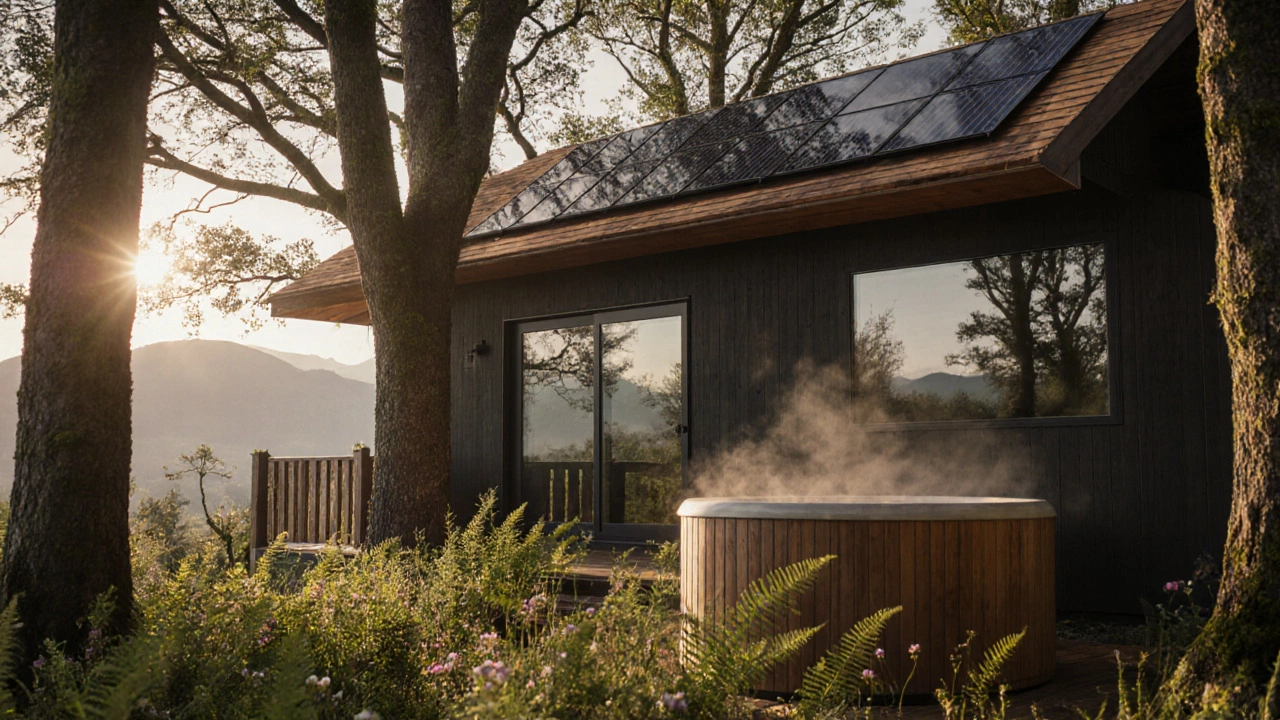Ever seen a tent with a king-sized bed, a wood-burning stove, and a private hot tub overlooking a forest lake-and thought, "This isn’t camping"? You’re right. That’s posh camping. Also called glamping, it’s not about sleeping on the ground with a sleeping bag and a flashlight. It’s about stepping into nature without leaving comfort behind. And in 2025, it’s more eco-friendly than ever.
Posh Camping Isn’t Just Fancy Tents
Posh camping started as a niche trend for people who loved the outdoors but hated the hassle. No pitching tents. No freezing at night. No searching for a bathroom in the dark. Today, it’s evolved into something bigger: a movement where luxury and sustainability go hand in hand.
Think yurts with underfloor heating, treehouses with solar-powered lighting, and safari-style tents with real beds and en-suite bathrooms. But here’s what sets the best ones apart: they’re built to disappear into the landscape. Materials are reclaimed wood, rainwater is harvested, composting toilets are standard, and energy comes from solar panels or wind turbines. Some even grow their own herbs for meals.
It’s not about adding more stuff. It’s about doing more with less-without sacrificing comfort. A study by the Global Glamping Market Report in 2024 found that 68% of guests choose eco-conscious glamping sites because they want to reduce their environmental footprint, not just enjoy a nice view.
How Posh Camping Differs from Regular Camping
Traditional camping means packing a tent, sleeping bag, camp stove, and a lot of patience. Posh camping? You show up with your suitcase. The bed is made. The hot water is running. Dinner might be waiting-locally sourced, organic, and cooked by someone who knows how to turn wild mushrooms into a five-star dish.
Here’s how they stack up:
| Feature | Posh Camping | Traditional Camping |
|---|---|---|
| Accommodation | Pre-built structures: yurts, domes, cabins, treehouses | Tents you pitch yourself |
| Beds | Real mattresses, linens, pillows | Sleeping bags on foam pads |
| Bathroom | Private or shared en-suite with hot water | Public port-a-potties or outhouses |
| Power | Solar, wind, or off-grid generators | No power, or battery packs |
| Food | Often included, locally sourced, sometimes chef-prepared | Self-cooked or instant meals |
| Environmental Impact | Designed for low impact: composting, rainwater, renewable energy | Often high impact: disposable gear, litter, fuel use |
The biggest difference? Mindset. Traditional camping is about survival. Posh camping is about connection-with nature, with quiet, with yourself. And it’s designed so you don’t have to sacrifice warmth, safety, or cleanliness to get there.
Why Eco-Friendly Cottages Are the Future of Posh Camping
Not all glamping sites are created equal. Some just slap a fancy rug on a tent and call it luxury. But the real leaders-like those in the Irish countryside, the Scottish Highlands, or the Canadian Rockies-are building structures that blend into the land, not dominate it.
Take a typical eco-friendly cottage in County Clare: walls made from locally harvested timber, insulation from recycled denim, windows positioned to catch the morning sun, and a roof covered in wildflowers that attract bees. Inside, there’s no plastic. No synthetic fabrics. Even the soap is handmade from olive oil and lavender grown on-site.
These aren’t just nice touches. They’re intentional choices. A 2023 survey by the Irish Sustainable Tourism Board found that 79% of guests who stayed in certified eco-glamping sites said they felt more connected to nature afterward-and 62% said they changed their home habits because of it. One guest in Wicklow started composting after seeing how a glamping site turned food waste into garden fertilizer.
That’s the power of experience. When you see sustainability in action-not just read about it-you start to believe it’s possible. And that’s how real change begins.

What You’ll Actually Find in a Posh Camping Site
Let’s get specific. If you book a true posh camping experience today, here’s what you can expect:
- Real beds with organic cotton sheets and down pillows-not air mattresses.
- Heating from wood stoves or underfloor radiant systems, not space heaters.
- Water heated by solar thermal panels or biomass boilers.
- Lighting from LED fixtures powered by solar banks, with dimmable settings for evening calm.
- Bathrooms with composting toilets and greywater systems that feed into native plant gardens.
- Food from local farms, delivered in reusable containers. Some sites even offer foraging walks to pick wild berries or mushrooms.
- No Wi-Fi-or at least, no pressure to use it. Many sites encourage digital detoxes with board games, books, and fire pits.
There’s no TV. No minibar. No room service menu. But there’s often a basket of locally baked bread, a bottle of Irish cider, and a journal to write in. That’s the magic. It’s not about having everything. It’s about having what matters.
Who Is Posh Camping For?
It’s not just for couples on honeymoons or influencers with perfect lighting. It’s for parents who want their kids to see stars without getting bitten by mosquitoes. It’s for retirees who love nature but can’t sleep on the ground anymore. It’s for remote workers who need quiet, reliable power, and a decent chair to type at.
One couple from Dublin booked a glamping stay for their 25th anniversary. They didn’t want a fancy hotel. They didn’t want to drive three hours to a city. They wanted silence, warmth, and the sound of rain on a cedar roof. They got all that-and a hot bath under the stars. They came back and told six friends. Now, their whole book club does an annual glamping trip.
That’s the secret. Posh camping isn’t about showing off. It’s about feeling something real. And it’s becoming more accessible than ever. Prices in Ireland range from €120 to €350 a night, depending on the season and amenities. That’s less than a mid-range hotel in Dublin-and you get more peace, more nature, and more meaning.

How to Spot a Truly Eco-Friendly Posh Camping Site
Not every site calling itself "eco" deserves the label. Here’s how to tell the real ones:
- Check certifications: Look for Green Tourism, EarthCheck, or Ireland’s Sustainable Tourism Standard. These require audits-not just marketing.
- Ask about waste: Do they compost? Recycle? Use biodegradable cleaning products?
- Look at energy: Solar panels? Wind turbines? Or just a diesel generator humming in the background?
- See the land: Are they planting trees? Restoring wetlands? Protecting local wildlife?
- Read reviews: Guests who mention "felt like I was helping the land" or "the owner told me how the compost system works" are usually onto something.
A good site won’t just say they’re eco-friendly. They’ll show you how.
Where to Find the Best Posh Camping in Ireland
Ireland’s quiet corners are perfect for this kind of escape. Here are three standout spots:
- Glamping at Slieve Donard (County Down): Treehouses nestled in ancient woodland, with views of the Mourne Mountains. All energy is solar. Water is rain-collected. Even the fire pits use reclaimed wood.
- Wilderness Pods (County Kerry): Geodesic domes with heated floors and glass ceilings for stargazing. They partner with local fishermen for seafood dinners and run a zero-waste kitchen.
- The Quiet Farm (County Wicklow): A restored 1800s stone cottage with a solar-powered sauna and a wildflower meadow. Guests help harvest vegetables in season. No plastic on site.
Each one proves that luxury doesn’t have to cost the earth. In fact, the best ones help it heal.
The Bigger Picture: Why Posh Camping Matters
This isn’t just a trend. It’s a shift in how people relate to nature. After years of crowded cities, digital overload, and climate anxiety, people are craving spaces that feel alive-not just pretty.
Posh camping offers that. It gives you the quiet of the wild, without the discomfort. It lets you unplug without feeling guilty. And when done right, it gives back more than it takes.
That’s why it’s growing. In 2024, bookings for eco-glamping in Europe jumped 41% year-over-year. Ireland saw the highest increase in the UK and Ireland region. More people are choosing to spend their money where it makes a difference.
So if you’ve ever thought camping wasn’t for you-think again. Posh camping isn’t about escaping the world. It’s about stepping into it, the right way.
Is posh camping the same as glamping?
Yes, posh camping is just another name for glamping-short for "glamorous camping." Both refer to luxury outdoor stays with real beds, heating, and private bathrooms. "Posh camping" is often used to emphasize the high-end, eco-conscious side of glamping, especially when sustainability is a key feature.
Is posh camping expensive?
It can be, but not always. Prices vary by location and season. In Ireland, you can find eco-friendly glamping from €120 per night, which is often cheaper than a mid-range hotel in a city. The higher-end options-like private treehouses with hot tubs-can go up to €350. But you’re paying for comfort, design, and sustainability, not just a roof over your head.
Do posh camping sites have Wi-Fi?
Some do, but most encourage you to leave it behind. Many top eco-glamping sites limit Wi-Fi to one shared area or disable it entirely to promote digital detox. If you need to work remotely, look for sites that offer reliable power and quiet workspaces-some even provide solar-charged laptops for guests.
Can families stay in posh camping sites?
Absolutely. Many sites now offer family-friendly options: larger pods with bunk beds, outdoor play areas, and kid-friendly meals. Some even have guided nature walks designed for children. The key is to choose a site that welcomes families-check reviews or call ahead. The best ones make it easy for kids to explore safely and comfortably.
Are pets allowed in eco-friendly glamping sites?
Many do, but not all. Pet-friendly eco-glamping sites usually require pets to be leashed, clean up after them, and avoid sensitive wildlife areas. Some even offer pet beds and treats made from natural materials. Always confirm pet policies in advance-some sites have strict rules to protect local animals and plants.
If you’re ready to try it, start small. Book one night. Leave your phone in your bag. Sit by the fire. Listen to the wind. You might just find that the most luxurious thing you can do is slow down-and let nature take over.
